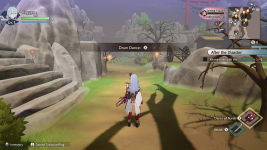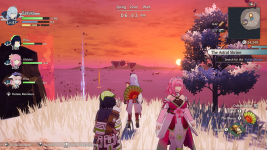After the Celestial Collapse, the runes' energy dwindles and ceases to flow throughout the Eastern lands of Azuma, stagnating nature and its inhabitants. As either Kaguya (Female) or Subaru (Male), you awaken from a dream of dragons fighting in the sky. To absolutely nobody's surprise, you have amnesia—a fairly common gaming trope at this point.
As a glorified shrine maiden, you're tasked with keeping a shrine to an unknown god clean and to offer prayer, until one day when you're approached by a flying wooly with horns and are inevitably tasked with finding a way to restore the village and remove the corruption set upon it by the Collapse.
The story is of the classic "Save the Four Elements" variety, but the characters and environments help keep everything fresh in this ~33 hour Rune Factory spin-off. There are no twists or turns to be found here with pretty much every major story event being either heavily foreshadowed or completely spelled out for the player.
A certain un-marry-able mom from Rune Factory 5's child, now grown, makes an appearance and is sure to be a fan favorite pick for marriage candidate, along with 13 others in the base game and two from the "Seasons of Love" DLC pack. There is roughly double that number of other important NPCs to interact with daily and complete tasks for spread out across the four different villages in the game.
Technically Speaking...
Let's address the elephant right away—the Switch as a console is weak tea. Even when overclocked, Rune Factory 5 chugged in the Unity engine and left a bad taste in everyone's mouth. Luckily, the team behind Guardians of Azuma used the Unreal Engine which has a much better performance track record on the console. Even on stock clockspeeds Guardians plays perfectly fine, though this isn't without sacrifices when looking at the draw distance and larger texture quality.
It appears the developers opted to crunch down textures to a bare minimum and employ both billboarding and distance rendering techniques, which cause a lot of pop-ins for the environment, while keeping the character models loaded in full detail. I feel this tradeoff was probably the best of the limited options they had to try and get the game running smoothly on the previous gen hardware right before the launch of the Switch 2.
Luckily, the Eastern (Japanese) style of the environments and villages along with the higher detailed enemies and people really help the eye gloss over the muddy textures while playing, and it stopped bothering me after I stopped looking for it. Using large particle effect attacks do cause some slowdown and frame loss, but it never got to the point where it bothered me the way Rune Factory 5 did.
Kairosoft? In MY farming sim!?
The main character is gifted with a magical multi-tool (Farming Life in Another World, anyone?) that completely removes the need to swap tools, refill your water pale, or even upgrade it and it doesn't use even a single RP to swing. It sits in a weapon wheel with your other mystical treasures, but doesn't need to be selected as all the gardening plots, rocks, and trees are context sensitive and your character will automatically use the appropriate transformation when available.
Anyone familiar with Kairosoft games will instantly pick-up on the village building mechanics of Guardians of Azuma. Each village has abandoned sections of plots ripe for development by yours truly. When entering edit mode, you can change the camera to a God's Eye view to place, remove, rotate, and do just about anything else you want to while organizing shops, decorations, and monster pens.
Different buildings and decorations can have "collection" types that, when placed together in the same region, boost the effects of the pieces. The villagers themselves don't seem to care what their town looks like, so you're free to cram everything in a corner if you aren't that great at public design (me) and just want to collect the stat bonuses that they give.
Crops can also be interacted with in this way, completely removing the need to walk to each plot individually to plant seeds or water... not that you'll be doing much farming in this game. Each town has its own set of residents that need to be assigned to different jobs based on their inherent skills and perks: Farmer, Miner, Arborist, Shopkeep, and Animal Handler.
While at first glance, the town management may seem overwhelming, the game doesn't ask a lot of the player and everyone in town will be perfectly happy with a rating of 100 without any interaction on your part once the few basic buildings are placed. Any rabble-rousers with the Lazy and Heavy Eater traits, for example, can simply be kicked out of the village without so much as a 30-day notice and someone will come to take their place the very next day.
In a new twist on the series, every farmed crop drops a seed of the same type which means, essentially, infinite crops with no up-front costs. Your farmers will automatically harvest and replant the appropriate plants for the season at the highest level available and place them in the shipping box, where you can retrieve them for personal use or let them be sold off for income. Long gone is soil or runey management, in favor of a mystical relic (unlocked eventually) that can burn away the crops and leave you with a pocket full of (potentially) higher level seeds.
Relationships are a cinch with many ways to increase your rating level each day. Along with the standard "speak" option, there is a "Hang Out" option that takes a set number of minutes out of the very generous daily timer. You can choose to give a plain ol' gift or take the lucky guy/gal on one of the many activities in an attempt to find their favorite activity for a large boost to their meter. By the time you reach the end of the game, even if you're rushing, you should have at least a couple of friends close to max as they also gain points from helping you in combat, which leads to unlocking more combat prowess and powers as their relationship level increases.
The strongest part of Guardians is all of the charming characters and how they travel between each of the towns as you unlock them, making the entire world feel connected as they stop by to shop, grab a snack, or hit up the onsen for a quick bath. Never before have I felt a farming/life sim that had such an interconnected relationship between the different areas and cast. Luckily, the map provides a list of all the important NPCs in that village, so you don't have to wander around trying to find a particular person and waste time on loading screens.
Combat and Spoils
The itemization and skill tree is probably the weakest aspect of Guardians of Azuma. While the mainstay sub-jobs of Alchemy, Blacksmithing, Cooking, etc. exist, they are extremely watered down and, in my opinion, completely useless. The amount of weapons, armor, and accessories is extremely truncated and all come to you in order with a well-metered power creep. This isn't necessarily a bad thing, in fact, it's great for newcomers to the series in not overwhelming with the massive amount of random stat/enchantment/elemental options seen in other Rune Factory games.
While there are no more skill orbs, and all magic uses the same animation and attack style, it doesn't really matter a whole lot because the best weapon in the game is given to you early on and it scales with you. Swords, bows, and magic are free to use and no longer cost RP. Your RP bar is entirely reserved for your Relics you acquire as the story progresses. The entire combat system was simplified and, because of this, you're never going to come across a wild randomly generated weapon in a chest. In fact, all of the treasure littered throughout the world kind of sucks. I was never once excited to open a chest as they all only contained mundane items.
Long gone are recipe breads, replaced by frog statues and shrines that dole out recipes in prescribed order as you visit new areas and run around on the incredibly dense maps, filled to the brim with landmarks to visit and things to collect.
Different actions acquire unique experience points for that action, as per Rune Factory modus operandi, but now those points can be spent on their respective skill trees. While most of the major nodes can add some crit, elemental damage, or other effects to other weapons outside that tree, all of the minor stat nodes are absolutely useless, no matter how you look at it. Adding one to three points to your strength means nothing when you can run back to down and build a statue of an Oni that grants you several hundred points of strength with no special resources required.
The combat is also so laughably easy that you'll never find yourself crafting new armor or weapons out of necessity. Seriously, the Fan is so broken (at least in version 1.0) you'll just decimate enemies with one or two waves. Equipped with an item that slowly regenerates RP, not even the post-game dungeons stand any chance of killing you. My recommendation? If you've played any Rune Factory before, crank the difficulty up to the max.
Boss fights include a stagger meter which, when filled, knock down the boss and allow you to deal bonus damage. When using the correct elemental weakness, it's possible to remove 90% of a given boss' health with a well-timed ultimate move and the correct relic equipped. The perfect dodge mechanic also feels really good and gives you plenty of frames to execute, negating the entire attack's damage (including all other projectiles that were a part of it) and slowing down time just long enough to deliver two charged attacks with your favorite weapon or magic. I really hope we get to see these just as fleshed out in Rune Factory 6.
So where does this leave the game in terms of balance? I think Guardians of Azuma fits nicely into a package that lets new players explore the different crafting systems typically found in Rune Factory without requiring a PhD and 12 tabs open to a wiki page. The combat is easy enough for casual game players to not get frustrated and the town building is simple, but also fun and rewarding. The social interactions are cute and engaging with lots of events and sub-stories to immerse yourself in. If you want an entry to the franchise that's easy to digest, this is it. Grab it to prepare yourself for the next mainline entry.
The long-time Rune Factory player may get frustrated and completely abandon the crafting, as you won't really need any of the items to complete the main and post-game story because of how easy it is. In fact, I was able to complete the game in just the first season/month and had plenty of time to explore every map completely and do most of the side tasks and finished with an overwhelming amount of resources while never once came close to dying. These folks may want to hold off, or catch this title when it goes on sale (including the DLC containing the best marriage candidate, Pilika).











Recommended Comments